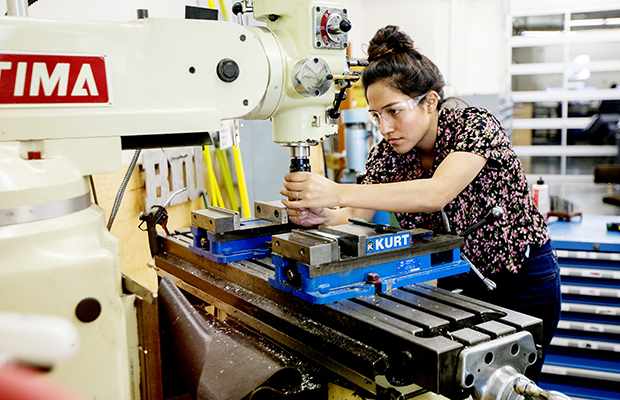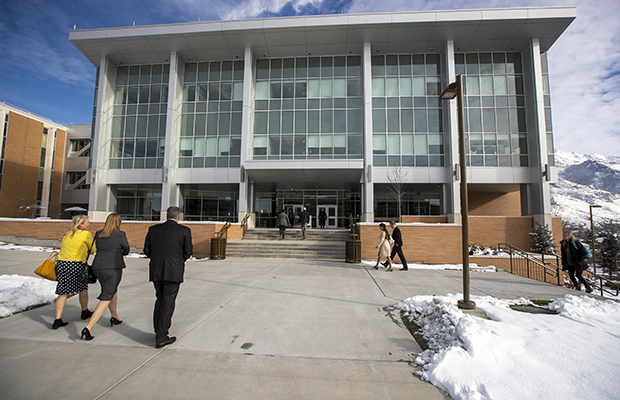Elder Bednar Dedicates New High-Tech BYU Engineering Building
Contributed By Marianne Holman Prescott, Church News staff writer

Students walk past the new BYU Engineering Building at BYU in Provo on Tuesday, December 4, 2018.
Article Highlights
- Elder Bednar offered the prayer at the dedicatory service on December 4.
- The new Engineering Building houses classrooms, labs, and project and office space.
“I hope that you, like Harvey Fletcher, engage in educational work that is second to none, while having instilled in your very being your duty to God and your fellow man.” —Kevin J Worthen, BYU president
Related Links
PROVO, Utah
A “new season” has begun for engineering students at Brigham Young University after the dedication of a 200,000-square-foot building and research lab for the college.
Known for its impressive innovation with energy-efficient vehicles, self-flying drones, rocketry, and developments in wheelchair capabilities, the Ira A. Fulton College of Engineering and Technology has a new place to call home—one that is now equipped to accommodate more creativity and growth than ever before.
“[The building] is a result of a lot of planning and a lot of generous donations,” said BYU President Kevin J Worthen during the dedicatory service on December 4. “I like to think of it as one of the temples of learning seen in vision by several during the early days of this institution. It exists as a result of the extraordinary efforts of many.”
Officially named the Engineering Building, the new space follows the pattern of recent structures constructed on campus of being named for what is housed in the building, rather than being named after a person.
Located on the southeast corner of the Provo campus, the new five-story building—and an adjacent research laboratory—includes classrooms, teaching labs, research labs, experiential learning project space, and office space. More than 17,000 donors funded 100 percent of the $85 million price tag for the building.
“This building was meant to inspire the students to continue their innovation,” said Mallory Platt, one of the architects from VCBO Architecture who worked on the project. “We worked closely with the faculty, making sure what they wanted was represented here.”
While the top few floors of the new building look like modern classrooms, team rooms, and office space, the “innovation floor” of the building focuses on building and problem-solving. “Project bays” house a variety of projects each semester, and include tools, workspace, and materials. The research laboratory includes two wind tunnels, a water tunnel, engine test facilities, and combustion reactors. Harvey’s Café, named in honor of Harvey Fletcher, the first dean of the college, resides on the ground level.

Fun facts about the new BYU Engineering Building. Courtesy of Aaron Thorup.
Although students have been using the space since the beginning of the fall semester, the official dedication marks the beginning of a new era for engineering students, said Elder David A. Bednar of the Quorum of the Twelve Apostles during the dedicatory service.
There are two fundamental reasons for holding such an event, Elder Bednar taught. First, dedications are held to express appreciation and gratitude. Second, dedications are held to celebrate “a new season” for the college.
Sharing the experience he had while serving as president of Ricks College (now BYU-Idaho) in Rexburg, Idaho, Elder Bednar told of his responsibility to oversee the fate of the Spori Building, the college’s first building ever built on campus and completed in 1903.
Because it had originally been built with limited resources and was well used for a century, the building was in need of major renovations and had become dangerous.

Visitors walk the stairs to a reception after Elder David A. Bednar of the Quorum of the Twelve Apostles delivered the dedicatory prayer for the new Engineering Building at BYU in Provo on Tuesday, December 4, 2018. Photo by Scott G Winterton, Deseret News.
“We had engineering studies done by several firms, and there was a universal conclusion—this building has lived its useful life,” Elder Bednar recalled.
While there were attempts at a plan to restore the original building, the estimated cost and short lifespan of the proposed project left decision makers few options. They decided the building needed to be demolished.
During a community meeting discussing the plans, many opposed the decision, arguing that taking the building down would change the spirit of the community.
After much discussion, one person stood and shared the thought, “The spirit of the school is not found in the building, it is found in the people,” Elder Bednar recalled.
Looking at the new BYU Engineering Building with that same approach, Elder Bednar encouraged students and faculty members to move into the new season with gratitude.
“Today we honor the past as we move into a new season, a new engineering building, and a new engineering research laboratory,” Elder Bednar said. “I pray we will always remember those who have gone before.”
During the dedication, President Worthen shared the story of Harvey Fletcher, the first college dean in the engineering department and namesake of the school’s first engineering building on campus.

Elder David A. Bednar of the Quorum of the Twelve Apostles of The Church of Jesus Christ of Latter-day Saints talks to the audience prior to delivering the dedicatory prayer for the new Engineering Building at BYU in Provo on Tuesday, December 4, 2018. Photo by Scott G Winterton, Deseret News.
In 1900, a year after completing his 8th grade year, Fletcher, a young man born and raised in Provo, Utah, entered Brigham Young Academy. After spending the previous year working at a grocery store, he decided to go back to school, not because he felt he needed to further his education, but rather he thought it would be fun to be with his schoolmates again.
“Because he did not do the assigned work, he failed his first physics class,” President Worthen said. “But showing the resilience that we hope our students develop, Harvey retook the course and received the highest grade in the class.”
He would go on to earn a PhD summa cum laude from the University of Chicago, where he worked in the lab of a Nobel Prize–winning physicist. Fletcher later became the head of the physics department at BYU and a professor of electrical engineering at Columbia University and established himself as the “father of stereophonic sound” for his work developing an early electronic hearing aid.
His work in the engineering field—acoustics, electrical engineering, speech, medicine, music, and physics—more than qualified him for his job as the first dean of the College of Physics and Engineering Sciences at BYU in the 1950s.
“Harvey’s was a remarkable journey, a journey from failing physics, whose main ambition was to simply hang out with his classmates, to an award-winning physicist,” President Worthen said.
At the age of 69, when most of his contemporaries were winding down professionally, Harvey took on the responsibility of developing the engineering program at BYU.
“He was a leader in his field of study, and also as a person he demonstrated that it is possible to be a world-class scholar, while being unquestioningly loyal to the principles of the restored gospel of Jesus Christ,” Worthen said. “That we can succeed in the world of work, in the world of ideas and not despite our faith in Christ, but because of it.”
Two hallmarks of Fletcher’s work—a commitment to excellence as well as loyalty to the restored gospel of Jesus Christ—are important for students today, Worthen taught.
“As we begin in this new engineering building, I hope that you, like Harvey Fletcher, engage in educational work that is second to none, while having instilled in your very being your duty to God and your fellow man.”
Today there are 4,200 students in the college of engineering at BYU, where 11 different degrees are offered—chemical engineering, computer engineering, cybersecurity, industrial design, manufacturing engineering, technology and engineering studies, civil engineering, construction and facilities management, electrical engineering, information technology, and mechanical engineering.
“Our students built this,” said Jay Christofferson, chairman of construction and facilities management in the college of engineering. “Every time we see a building go up on campus our students have been successful in managing and organizing the project.”

Elder David A. Bednar of the Quorum of the Twelve Apostles talks to the audience prior to delivering the dedicatory prayer for the new Engineering Building at BYU in Provo on Tuesday, December 4, 2018. Photo by Scott G Winterton, Deseret News.

Mechanical engineering student Diana Bolanos works on a mill in the new engineering building after Elder David A. Bednar delivered the dedicatory prayer for the new Engineering Building at BYU in Provo on Tuesday, December 4, 2018. Photo by Scott G Winterton, Deseret News.

Students and visitors walk the halls after Elder David A. Bednar delivered the dedicatory prayer for the new Engineering Building at BYU in Provo on Tuesday, December 4, 2018. Photo by Scott G Winterton, Deseret News.

Visitors arrive for the dedication of the new Engineering Building at BYU in Provo on Tuesday, December 4, 2018. Photo by Scott G Winterton, Deseret News.

Visitors walk past engineering projects in the new Engineering Building on BYU campus on Tuesday, December 4, 2018. Photo by Scott G Winterton, Deseret News.
